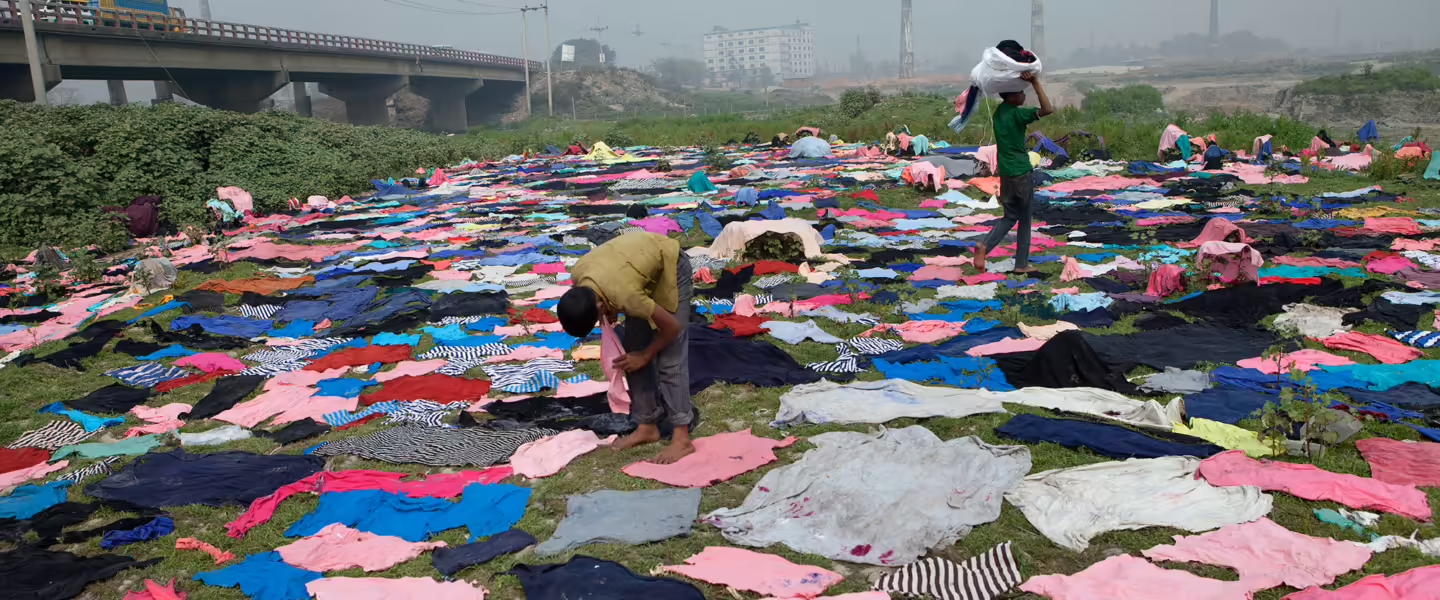Welcome to Saturday Hashtag, a weekly place for broader context.
|
Listen To This Story
|
The fast-fashion/textile industry represents an important part of the global and US economies, employing over 300 million people with valuation estimates between $1.7 trillion and $2.5 trillion.
However, there is a major overhead cost that is not part of this profit calculus: the rapid increase in the global municipal solid waste (MSW) stream caused by the industry.
Globally 75 percent of all textile waste is landfilled, which equals 92 million tons every year. This is like burning a truck load of clothing every second.
From 2000 to 2015 global textile production doubled to approximately 100 billion items per year, with a projected increase of 63 percent by 2030, when textile waste is expected to reach 134 million tons a year.
The majority of global textile waste goes directly to developing countries, largely in the Global South.
The US alone throws out more than 34 billion pounds of textiles yearly; that’s more than 100 pounds of textile waste per person. Sixty-six percent of discarded US textiles end up in US landfills. The communities near these landfills have a significant health risk.
Every year this industry contributes 3.9 billion tons of CO2 equivalent emissions, representing 8 to 10 percent of the Earth’s total CO2 output. This is greater than the entire global aviation industry.
The textile sector is one of the biggest polluters in the world and in fact, it is the biggest in Europe.
This industry also consumes an incredible amount of fresh water and arable land locally which causes consumable water and agricultural land shortages in these areas across the US.
***
This waste now poses a significant risk to human health because the textile industry has shifted away from natural materials to cheaper petroleum based materials, 57 percent of fibers produced in 2022 were derived from fossil fuels.
This material is literally contaminating the global ecosystem.
The dramatic growth of synthetic fibers in the industry (63 million tonnes of polyester in 2022) is the result of population explosion, heightened demand for cheaper man-made fibers, international and US government industry initiatives, increased influence of emerging markets, and global restrictions on plastic usage.
This dire situation has led to the development of the circular economy. This is an attempt to economically address issues related to climate change — biodiversity loss, waste, and pollution — by keeping materials and products in circulation for as long as possible. It is based on three principles: eliminate waste and pollution, circulate products and materials (at their highest value), and regenerate nature.
The US government along with several NGOs (e.g. the Council of Foreign Relations) are working to promote this idea, and even passing legislation. Europe is also implementing several policies. There is even a chemical industry acknowledgement of the toxicity problem.
These new policies have opened up some profit driven options for the textile industry, like green fabrics and eco fibers. The sustainable textile sector is estimated at $58 billion in 2024 and is projected to reach $99.5 billion by 2030 with a compound rate of growth of 9.4 percent between 2024 and 2030 (e.g. Econyl and Tencel).
Whenever profits are part of the equation, industry can always be counted on to take up the mantle… or at least in this case just admit it needs to be picked up, and perhaps not be made of poison.
The Sustainability Trends Report 2024
The author writes, “Climate promises are starting to resemble New Year’s resolutions: easy to make, hard to keep. The worldwide push to stem the climate crisis has drawn in many of the big institutions that most need to act: not just governments but corporations of all kinds, including big banks and other institutional money managers, commodity producers, consumer products companies and many more. Even the companies digging or pumping fossil fuels out of the ground are feeling the pressure to make commitments. We are disappointed to report that the past few years have seen a wave of backsliding on those climate commitments, however.”
Why 2024 Is the Year Sustainability Develops a Credible Business Case
The author writes, “Sustainability is becoming a priority investment area, increasingly viewed as an opportunity to create value. At the end of 2022, only a third of organizations intended to increase their sustainability investments. Today, the proportion is over half.”
The Most Promising Fabric Innovations in Sustainability in 2024
From Good on You: “In 2024, what are the fabric innovations to look out for, and where are the names we know at right now? Read on to find out.”
Fast Fashion Goes To Die in the World’s Largest Fog Desert. The Scale Is Breathtaking.
From National Geographic: “The Atacama Desert in northern Chile stretches from the Pacific to the Andes across a barren expanse of red-orange rock canyons and peaks. As one of the driest deserts on Earth, it’s a bucket-list destination for stargazing tourists who come for some of the clearest views of the night sky. … But the Atacama has also attained a less wondrous distinction as one of the world’s fast-growing dumps of discarded clothes, thanks to the rapid mass production of inexpensive attire known as fast fashion.”
Ghana: Report Says Global North’s Fast Fashion Fueling Environmental Crisis
The author writes, “Although trade in used clothing has long been an integral economic activity in Ghana, the massive influx is becoming an environmental catastrophe with worse implications for ocean life and human health.”
Why We Need to Phase Plastic Out of Fashion
From the Plastic Pollution Coalition: “While your fit may ‘be fire,’ as GenZers like to say, beware of open flames: At least 69 percent of clothing is currently made of highly flammable and toxic plastic. We urgently need to phase plastic out of fashion: Plastic pollution has surged with the rise of plastic fast fashion — bringing with it devastating impacts on our health and the environment when produced, used, and discarded.”
UN Alliance for Sustainable Fashion Addresses Damage of ‘Fast Fashion’
The author writes, “The UN Environment Assembly is seeking to halt the environmentally and socially destructive practices of fashion, and instead harness the industry as a driver for improving the world’s ecosystems. The average consumer buys 60 percent more pieces of clothing than 15 years ago. Each item is only kept for half as long.”




